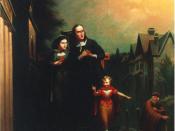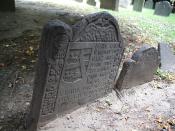In a novel of sin and redemption, symbolism is used to broaden the significance of certain aspects. Throughout The Scarlet Letter, Hawthorne uses a barrage of themes, motifs, and symbolisms. These images help to unify the novel and enrich the meaning behind the work. Early in the novel, Hawthorne refers to iron, oak, chains mainly to demonstrate the Puritanism that takes place in the novel. However, he also uses these symbolic items to display the bonds between characters and what they believe in. In the first paragraph of the novel, Hawthorne describes the prison door "which was heavily timbered with oak and studded with iron spikes" (Pg. 33) to flaunt the austerity and illustrate what times were like right off the bat. He uses verisimilitude to liken the callousness of the puritan ethic to the portal behind which go the criminals who don't follow these guidelines. The symbolism in this situation is used to intensify the importance of the puritan ethic in the novel.
To elucidate Hester's desire to move back to England, and her morals for staying, Hawthorne states that "The chain that bound her here was of iron links, and galling to her inmost soul, but never could be broken." (Pg. 55) Even though she knew she could move back anytime she wanted, Hester felt fervent on staying in New England to prove herself to everyone. In this case Hawthorne used symbolism to enact the bond between man and nature. Hester was bound to the land through a chain of fulfillment. Hawthorne also uses symbolism to form a correlation between different chapters in the novel. On the first page, Hawthorne describes the prison door as a portal to doom. In The Governor's Hall, Hawthorne described the Governor's door as a door to liberty. If Hester "lifted the...


